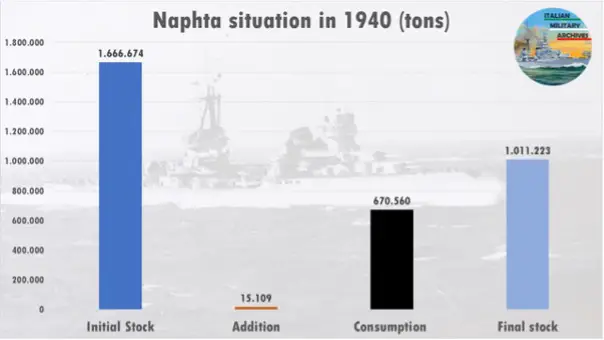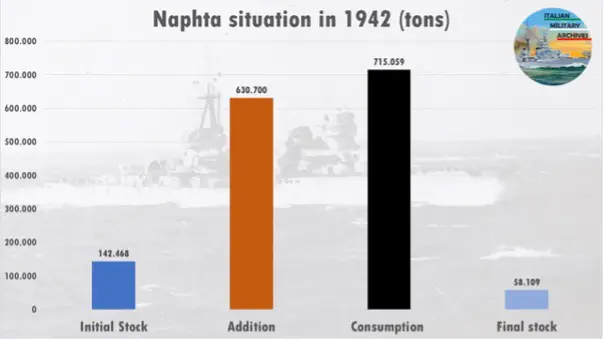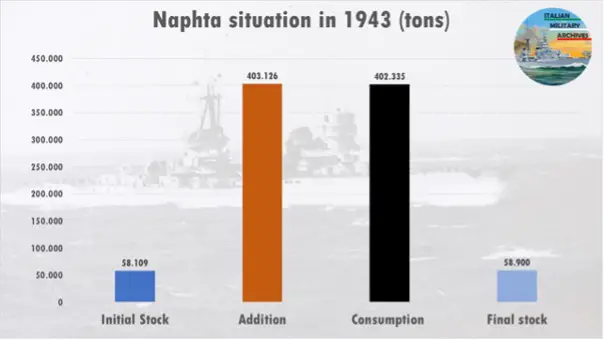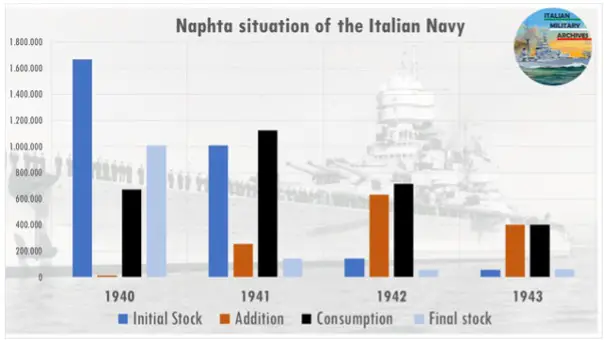Naval operations require a lot of fuel, specifically naphtha for most WW2 era navies. A stable and consistent supply of fuel is then essential for any navy to run its operations and try to achieve command of the seas. Fuel availability was a very delicate issue for the Italian Navy in WW2, Italy did not have significant domestic production and thus had to rely on imports. This brings us to the fact that almost the entire world’s oil production back then, was controlled by the Allies, while the Germans and the Italians could only rely on the Romanian oil production, plus some residual supplies grabbed in occupied countries. With the German war machine absorbing most of the fuel available in Axis controlled Europe, Italy and its Navy had to carefully manage its naphtha stocks and the use of it.
In the 2-3 years before the outbreak of WW2, the Regia Marina had wisely stockpiled a consistent amount of naphtha. The result was that in June 1940, the Italian navy could rely on around 2 million tons of naphtha. This amount was considered sufficient to cover 12-18 months of operations. However, in the first weeks of the war, the Government and the Air force took around 300.000 tons from the Navy stockpile. By the first of July 1940, the naphtha available to the Italian Navy was down to 1.666.674 tons.
Most of the oil imported from Romania in 1940 supplied the Army and the Navy and only 15.000 tons were at the end allocated to the Regia Marina. Coupled with the consumption of 1940, the year ended with the naphtha stockpile reduced to 1.011.223 tons. The higher consumptions of 1941 further reduced the stockpile. The convoy crisis of November 1941 forced the Regia Marina to employ its battleship force to allow the safe passage of some vital convoys directed to North Africa, this was only possible thanks to an extraordinary naphtha shipment from Germany of around 80.000 tons. At end of the year, the total naphtha available to the Regia Marina was down to 142.468 tons.

In the early months, the situation deteriorated further because of a drop in Romanian and German supplies. In April, the navy stockpile reached its minimum of 14.000 tons available. If we consider that a single Littorio class battleship needed 4000 tons to have its tanks replenished, we can get a clear picture of how the situation was dire. However, from the end of April, the fuel flow from Romania was re-established and the navy could receive 50.000 tons a month. To spare more naphtha, the Regia Marina suspended the mine-laying operations carried out by cruisers. These measures allowed the Italians to deploy the majority of their surface fleet against the allied operations Harpoon and Vigorous in June 1942.
In August, only a limited portion of the surface fleet was deployed against Operation Pedestal and the battleships will not see any more action due to the fuel limitations. In 1942 the new naphtha supplies amounted to 630.700 tons while the consumption reached 715.059 tons. At the end of the year, the overall stockpile was down to 58.109 tons.



In 1943, the strategic situation for the Axis was compromised in the North African theatre, but still, the Regia Marina supplied the Italian and German forces in Tunisia until May 1943, thus keeping the consumption relatively high. By that time, most of the surface forces were unable to move, due to the absence of any naphtha reserves left. Nevertheless, between the 8th and 9th of September, the Italian fleet managed to leave their bases and reach Malta, following the prescriptions of the Armistice between Italy and the allies. Andrea Piccinotti writes that this was possible for the following reason:
“When the Germans unexpectedly occupied the French base of Toulon on November 27, 1942, where most of the French fleet still afloat was kept, they were able to capture 80,000 tons of oil fuel. Having realized that the Regia Marina could not launch any offensive mission, the Germans transferred “on loan” 60,000 tons of “special” oil fuel thus allowing for the three battleships to be reactivated, along with the cruisers of the 7th and 8th Division, the light cruisers based in Taranto, and, at the end of June, the old battleships Cesare, Doria and Duilio.”

Sources
Piccinotti, A. (s.d.). Carenza di nafta . Taken from da regiamarina.net: http://www.regiamarina.net/detail_text.asp?nid=125&lid=2
USMM. (1950). La Marina Italiana nella seconda guerra mondiale, Volume 7, Dati statistici.